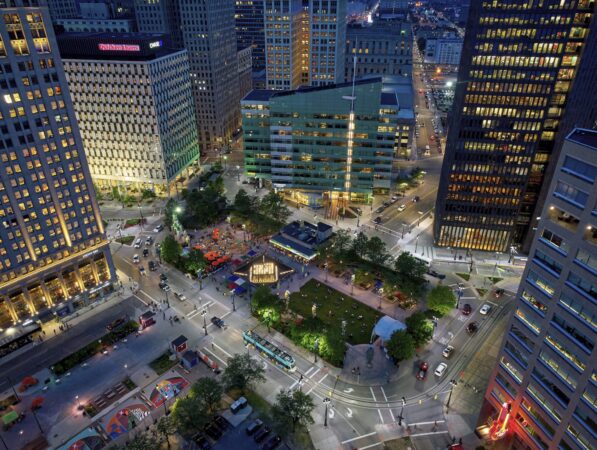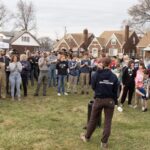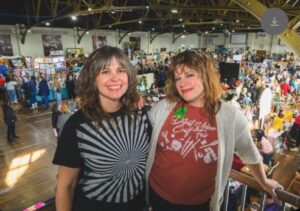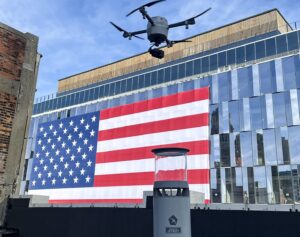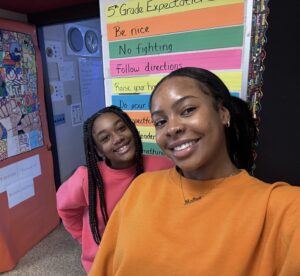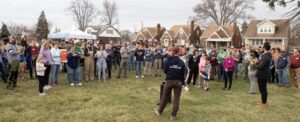According to the Downtown Detroit Partnership Annual report, people are returning to the city. There were 22 million visits made to downtown Detroit in 2021, up 63% from 2020. The city’s parks and public spaces welcomed more than 4 million visitors via nearly 1600 events. The downtown workforce, now at 40% of 2019 occupancy, is expected to climb to 70% by the summer and remain there.
Yes, people are coming back. But will the city be the same, or will some things be forever changed?
DISRUPTION HISTORICALLY CHANGES THINGS
Indeed, if we go back in time we can see that certain disruptions – catastrophes – can shift the very essence of the world. 66 million years ago the Cretaceous–Paleogene (K-Pg) extinction destroyed the dinosaurs and freed up space for mammals – humans. Going back even further, the Oxygen Catastrophe 2.5 billion years ago destroyed most anaerobic life and set the stage for us oxygen-breathers. Had these things not occurred, humans and many other living species would likely never have come into existence.
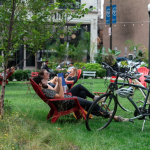
OUTDOOR SPACES CREATE A RELAXING REFUGE DURING THE PANDEMIC AND BEYOND
Fast forward, if we look at the history of cities – one thing we can see is that they are resilient, and can bounce back from disruptions ranging from pandemics to wars to recessions. In the 1850s, London was devastated by cholera but once solved, the population quickly doubled. The Spanish flu a century ago was quickly followed by the Roaring ’20s. European cities devastated during World War II were strong and prosperous by the 1960s.
Catastrophes force us to view things differently, work and bond together in new ways and with urgency, and accelerate innovative thinking and – change.
So what pandemic-initiated changes seem to be in store for the future of Detroit?
THE BUILT ENVIRONMENT
One colossal and global shift the pandemic brought is the way that people use space. How they move about. Operate within spaces. And that urban built environment will likely forever be changed.
Gone are the days of the traditional and separate ‘commercial district’ and ‘residential district,” says Roxbury Group Owner, David Di Rita. “When it comes to office and residential those lines have been blurred for some time and COVID-19 is pushing this forward and leading us to new ways to think about development.”
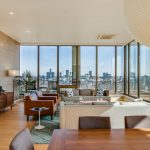
DAVID WHITNEY BUILDING PLAZA – COURTESY OF ROXBURY GROUP
He goes on to say, “If the estimate holds true regarding downtown office space capping at 70% of pre-pandemic occupancy – which I think it will – this will free up space and create gaps for new businesses to come into the city, for us to accelerate the mixed-use model, and for us to totally rethink how we use these spaces. This will rearrange itself and post COVID-19 things will look different, but that’s healthy. It will help to create a more vibrant city.”
To that end, Francesca Eid, Bedrock’s Vice President of Experience says, “The Central Business District continues to shift to become a place where people can live, work, and play. We’re also excited to begin moving beyond the traditional Central Business District to bring further activity and places to live, work and play to areas of Detroit such as Brush Park, the Riverfront, and Delray.”
Another institutionalized change is the use of the space inside the buildings.
Di Rita says,
There is a big shift in how people operate and live within multifamily and hotels now. We see this in the David Whitney building. The lobby is buzzing all day long with people utilizing it differently than pre-COVID. Residents and guests are scattered everywhere on laptops and on zoom meetings and using open spaces as large communal workspaces. People want to get out of their apartment or hotel room but maybe not out of the building. From a development standpoint, we have to rethink bringing more amenities into the building and designing to accommodate for this going forward.
HEADING – AND REMAINING – OUTSIDE
Another common theme that emerged from the pandemic across the country is the importance of outdoor space.
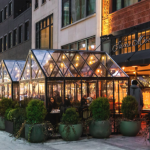
HEATED OUTDOOR SEATING AT SAN MORELLO – COURTESY OF BEDROCK
One welcome surprise that’s largely here to stay is outdoor dining. From Bedrock’s many heated open-air pergolas to heated igloos scattered across the city winterscape to outside patios with firepits, the need to convene and commune has been creatively supported. “This was not only necessary, but extremely successful business plans have emerged,” says Eid.
Antoine Bryant, Community Engagement, Urban Design & Planning Thought Leader for the City shared, “It’s a bit ironic that it took a worldwide crisis for us to address space in a different way but here we are. COVID has driven us to become much more intentional about the programming for different populations in our parks, walkways, bike paths, and more.”
Eric Larson, Downtown Detroit Partnership CEO, weighs in but first acknowledging that the importance of public spaces has been a priority and focus for the DDP throughout its 100-year history. COVID-19 certainly brought that to light. “Our outside spaces need to be designed and programmed for equitable access for all. This will continue to be an important role in the overall social fabric of the community not only for the DDP but all stakeholders as we move forward. We worked together to help all our members pivot to embrace our parks and green spaces and rethink how we use our streets and sidewalks.”
Bedrock has been heavily involved in the programming of outside spaces to bring community together and visitors downtown as well, having launched Monroe Street Midway including the Monroe Street Drive-In, Rollout Detroit, Rocket Mortgage Sports Zone, and performances, Downtown Detroit Markets, and outdoor during the pandemic.
SHINING THE SPOTLIGHT ON INEQUITY AND DIVIDE
For Detroit and cities around the world, COVID-19 acted as a mammoth spotlight highlighting inequity and other urban challenges.
One great example of this spotlight serving to accelerate change in Detroit is the digital divide.
As told by Joshua Edmunds, City of Detroit Director of Digital Inclusion, “The pandemic pushed the digital divide to the forefront in a way that people cannot ‘unsee.’”
He goes on to say that it likely accelerated the work around the digital divide by a decade.
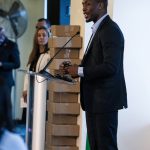
JOSHUA EDMUNDS WITH RESIDENT LAPTOPS
Since taking on his role in 2019, Edmund’s biggest challenge and mission had been awareness. “I was like a mosquito – I’d go to event after event at churches, book clubs, neighborhood meetings relentlessly to simply make people aware that I existed in this position and was doing this work so that we could grow and move it forward, and the pandemic came and put it in front of the world overnight.”
“Luckily we had the ECOSYSTEM in place to act – Detroit was a bit ahead of the curve. We had received a half million investment from GM and had the Connect 313 concept in place. Connect 313 is a citywide, data-driven digital inclusion strategy that brings countless organizations together with the bold goal to make Detroit a national model for digital inclusion and ensure all Detroiters can access the digital world and the opportunity it brings
“In 2020 Rocket Mortgage and the Rocket Community leaned in on the digital inequity in a big way and helped us bring Connect 313 to life. We were able to quickly put neighborhood tech hubs and ambassadors in place to bring it to life.”
In Q1 of 2021, Connect 313 mobilized to promote the Emergency Broadband Benefit national program in Q1 of 2021 which has resulted in over 82,000 residents gaining online access – and counting.
IMPARTATION AND COMMUNICATION
Another change that is here to stay is the way we communicate. The pandemic clearly accelerated and drove the use of virtual communication across every sector. And for Bryant, this translated to hearing from more residents.

ANTOINE BRYANT, DETROIT URBAN DESIGN AND PLANNING
He says, “From a planning standpoint our work is built upon engagement of and insights from the public… the residents as stakeholders. Pre pandemic we’d hold public meetings, utilize newsletters and emails to communicate, but the pandemic changed the game. Where we used to have 20 people attend an in-person public meeting, we suddenly had 150 online. This has been a tremendous asset to us from a planning standpoint.”
He goes on to say, “I think the sense of urgency and catastrophic nature of the pandemic also pushed us to have more intentional discussions with people we may not always talk to. No matter your race, gender, nationality, we have listened and regarded one another in a deeper way.”
HARNESSING THE MOMENTUM
It is incumbent upon all of us to continue acting with intention and urgency, and to continue communicating across all sectors and lines toward innovation and positive change.
In closing, Larson shares, “The pandemic crystalized a number of issues we’ve been wrestling with for decades and brought them to not only a heightened level of understanding but a higher level of importance. We must not lose sight of the disparity and inequities that surfaced. The city and community – residents, businesses, visitors – have greater clarity as to what we need to do to be a sustained vibrant, and successful city in the future.”
As always, be sure to subscribe to our newsletter for regular updates on all things Detroit and more.


